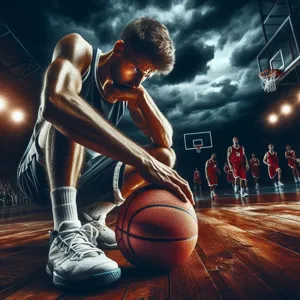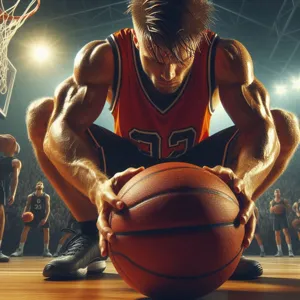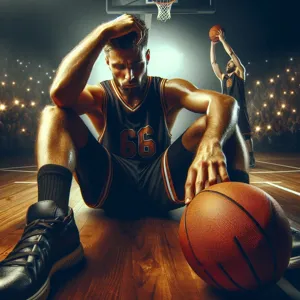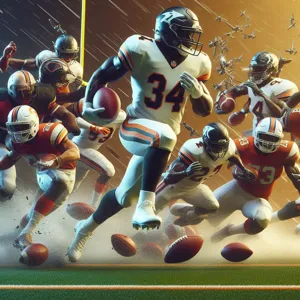Every basketball player knows that the journey to success is filled with ups and downs, and experiencing a slump can be one of the most frustrating challenges on the court.
Whether it’s a sudden dip in shooting accuracy, a lack of energy during games, or just feeling out of sync with your teammates, slumps can take a toll on your confidence and performance. However, the key to bouncing back lies in understanding the root causes of your struggles and implementing effective strategies to regain your rhythm. In this blog post, we’ll explore tried-and-true methods to help you break through the barriers of a basketball slump, from mental conditioning techniques and targeted practice drills to nutrition tips and the importance of a positive mindset. With the right approach, you can transform setbacks into comebacks and rediscover the joy of playing the game you love. Let’s dive in and get you back in the zone!
1. Understanding the Causes of a Basketball Slump

Understanding the causes of a basketball slump is the first critical step in turning your performance around. A slump can manifest in various ways—whether it’s a sudden drop in shooting percentage, a lack of energy on the court, or an inability to execute plays effectively. Recognizing the underlying issues is essential for creating an effective recovery strategy.
Several factors can contribute to a basketball slump. Physical fatigue, for instance, is a common culprit; the grueling nature of training and games can wear down even the most skilled athletes. If your body isn’t recovering properly, your performance will inevitably suffer. Additionally, mental fatigue plays a significant role. The pressure to perform, combined with the weight of expectations from coaches, teammates, or even yourself, can create a mental block that hinders your ability to play freely and confidently.
Another potential cause lies in technique. If you’ve been working on a new skill or adjusting your shot, it’s possible that the changes haven’t fully integrated into your game yet. In this case, reverting to foundational techniques and giving yourself time to adjust can be beneficial. Similarly, external factors—such as team dynamics, lack of communication, or even personal issues off the court—can affect your focus and commitment during games.
By taking the time to assess these various causes, you can pinpoint the specific elements contributing to your slump. This self-reflection is a vital part of the recovery process, allowing you to address the issue head-on and implement targeted strategies to regain your form. Whether it’s refining your skills, improving your physical conditioning, or simply taking a mental break, understanding the root of your slump is the key to bouncing back stronger than ever.
2. Recognizing the Signs of a Performance Dip
Recognizing the signs of a performance dip is the first step toward overcoming a basketball slump. As any seasoned player knows, a drop in performance can manifest in various ways, and acknowledging these signs early can make all the difference in turning things around.
One of the most noticeable indicators is a sudden change in shooting accuracy. If you’re finding that your usual range feels just out of reach or your free throws are clanging off the rim more often than not, it’s time to take a step back and assess your mechanics. Sometimes, misalignment in your shooting form can lead to a string of missed shots, signaling a need for adjustment.
Additionally, pay attention to your overall energy levels during practice and games. If you find yourself feeling fatigued or lacking the usual spark that fuels your hustle, it may be a sign that your mental or physical stamina is waning. This can lead to sluggishness on the court, making it more challenging to keep up with your opponents or to contribute effectively to your team.
Another critical sign is a shift in your mental game. If negative thoughts start creeping in after a missed shot or a poor performance, it can create a vicious cycle of doubt and anxiety. You may notice an increase in frustration or a tendency to overthink your plays, which can stifle your natural instincts. Recognizing these mental cues is essential for regaining your confidence and composure.
Lastly, observe your interactions with teammates. If you find yourself withdrawing or feeling disconnected from the team dynamic, this can impact not only your performance but also the collective spirit of the group. Open communication is vital, and sharing your struggles can foster a supportive environment that encourages growth and resilience.
By pinpointing these signs early—be it through changes in physical performance, mental state, or team dynamics—you can take proactive steps to address the slump. Embrace these indicators as valuable feedback, and use them as a foundation for your journey back to peak performance. Remember, every athlete experiences ups and downs; it’s how you respond that will ultimately define your success on the court.
3. Importance of Mental Resilience in Sports

Mental resilience is a key component of any athlete’s success, especially when navigating the ups and downs of a basketball season. When players find themselves in a slump, it’s often their mindset that needs the most attention. The ability to bounce back from mistakes, setbacks, and poor performances can separate the good players from the great ones.
In basketball, where the pace is fast and the pressure can be intense, having a resilient mindset allows players to maintain focus and composure even when the going gets tough. It’s about more than just physical skills; it’s about harnessing the mental fortitude to push through challenges and remain optimistic in the face of adversity.
Building mental resilience involves a few key practices. Visualization techniques can be particularly beneficial; by mentally rehearsing successful plays or imagining the ball sinking through the net, players can create a positive feedback loop that boosts confidence. Additionally, setting realistic goals, both short-term and long-term, helps athletes stay motivated and provides a clear path to improvement.
Mindfulness and meditation practices are also gaining traction among athletes, helping them to stay present and reduce anxiety. By focusing on their breath and centering their thoughts, players can better control their emotions and reactions during high-pressure moments on the court.
Finally, open communication with coaches and teammates fosters a supportive environment. When players feel understood and encouraged by those around them, they’re more likely to confront their challenges head-on. Emphasizing the importance of mental resilience not only helps players regain their footing but also cultivates a culture of perseverance and growth within the team. In basketball, as in life, it’s not just about how you fall, but how you rise again that truly defines your journey.
4. Analyzing Your Game: Self-Assessment Techniques
Analyzing your game through self-assessment techniques is a crucial step in overcoming a basketball slump. It’s all about taking a step back and scrutinizing your performance with a critical yet constructive eye. Begin by recording your practices and games; having video footage allows you to observe your movements, decision-making, and overall gameplay from a different perspective. When you watch yourself play, look for patterns in your performance—identify moments where you excelled and instances where you struggled.
Next, consider maintaining a performance journal. After each practice or game, jot down your thoughts, feelings, and observations. Reflect on what worked well and what didn’t. Did you miss free throws due to poor follow-through, or were you consistently out of position on defense? This written account serves as a powerful tool to track your progress over time and pinpoint specific areas needing improvement.
Additionally, seek feedback from your coaches and teammates. They can offer insights you might overlook and provide constructive criticism to help you grow. Engage in open discussions about your game, and don’t hesitate to ask for drills or strategies tailored to address your weaknesses.
Lastly, set measurable goals based on your self-assessment. Whether you aim to improve your shooting percentage, increase your assists, or enhance your defensive skills, having clear objectives will give you direction and motivation as you work to bounce back from your slump. By taking the time to analyze your game thoughtfully, you can turn setbacks into stepping stones toward future success.
5. Setting Realistic Goals to Regain Confidence

When faced with a basketball slump, it’s essential to recalibrate your mindset and set realistic goals that can help restore your confidence on the court. The pressures of competition and the expectations we place on ourselves can often lead to frustration; however, breaking down your objectives into manageable, achievable tasks can foster a greater sense of accomplishment.
Start by focusing on specific skills that may need improvement, such as free throw shooting, dribbling under pressure, or defensive positioning. Instead of aiming for a lofty target like “scoring 20 points in the next game,” set smaller milestones, such as “making 8 out of 10 free throws in practice” or “successfully executing three crossover dribbles during a game.” These micro-goals allow you to track your progress in real-time and celebrate small victories, which can be a tremendous confidence booster.
Additionally, consider incorporating a routine that emphasizes consistency over perfection. This could be having a dedicated time for shooting drills, working on footwork, or even dedicating a session to watching game footage and analyzing your plays. By focusing on these structured, incremental improvements, you’ll gradually build back your confidence as the skills you’ve honed translate into on-court performance.
Lastly, don’t forget to reflect on your journey. Keep a journal of your experiences, noting what works and what doesn’t. This self-reflection can help you see just how far you’ve come, reinforcing the belief that you are capable of overcoming your slump. Setting realistic goals not only provides a clear path forward but also reaffirms your commitment to growth and resilience in the game you love.
6. The Role of Physical Conditioning in Overcoming Slumps
### 6. The Role of Physical Conditioning in Overcoming Slumps
When it comes to breaking free from a basketball slump, physical conditioning plays a pivotal role that often goes overlooked. The truth is, basketball is an intensely demanding sport that requires peak physical fitness, agility, and endurance. If you’re feeling sluggish on the court, it might not just be a mental block—it could be a sign that your body isn’t operating at its best.
A well-structured conditioning program can enhance your strength, speed, and overall athletic performance, allowing you to play with greater confidence and energy. Start by assessing your current fitness level and identifying areas that need improvement. Are you struggling with stamina during those critical game moments? Perhaps you find yourself lagging in speed while defending against quicker opponents. Tailoring your training to address these specific weaknesses can make a significant difference.
Incorporating a mix of cardiovascular exercises, strength training, and flexibility workouts into your routine is essential. High-intensity interval training (HIIT) can boost your endurance and explosiveness, enabling you to sprint up and down the court without feeling worn out. Meanwhile, strength training will not only enhance your overall power and stability but also help prevent injuries that could further derail your game.
Don’t underestimate the importance of recovery and nutrition, either. Adequate rest and a balanced diet rich in proteins, carbohydrates, and healthy fats will fuel your body and help repair any wear and tear from training or games. Hydration is equally crucial; staying properly hydrated can significantly impact your performance and concentration levels.
Ultimately, improving your physical conditioning lays the groundwork for overcoming slumps. By investing time in your body, you’ll find that your confidence grows, your skills sharpen, and your ability to perform under pressure increases. When you feel strong and capable, the mental aspects of the game will follow suit, helping you bounce back and reclaim your rhythm on the court.
7. Practicing Mindfulness and Visualization Techniques

Practicing mindfulness and visualization techniques can be transformative in helping athletes regain their confidence and focus during a basketball slump. In the fast-paced world of basketball, where split-second decisions can make or break a game, mental clarity is just as crucial as physical skill. Mindfulness involves bringing your attention to the present moment, allowing you to observe your thoughts and feelings without judgment. This practice can help you clear your mind of distractions, reduce anxiety, and enhance your overall performance on the court.
Start by incorporating simple mindfulness exercises into your daily routine. Find a quiet space, close your eyes, and take deep breaths, focusing on each inhale and exhale. As thoughts about past games or future matches arise, acknowledge them without dwelling on them, then gently redirect your focus to your breath. This practice not only grounds you but also cultivates a sense of calm that can be invaluable during high-pressure situations.
Visualization techniques take this a step further by engaging your imagination to rehearse positive outcomes. Picture yourself executing perfect shots, making strategic plays, and celebrating victories with teammates. By vividly imagining yourself succeeding, you create a mental blueprint that can enhance your confidence and prepare you to perform at your best. It’s essential to visualize every detail—from the feel of the basketball in your hands to the sounds of the crowd cheering. The more realistic the imagery, the more effective this technique becomes.
Combining mindfulness with visualization fosters a holistic approach to overcoming a slump. As you train your mind to stay focused and positive, you’ll find that your performance on the court improves, your stress levels decrease, and your love for the game is reignited. Embrace these techniques not just as tools for recovery but as essential parts of your training regimen, and watch as you bounce back stronger than ever.
8. Seeking Feedback: Coaching and Peer Support
When you’re caught in a basketball slump, seeking feedback from coaches and peers can be a game-changer. It’s easy to become tunnel-visioned, fixating on your own performance and struggles, but gaining insights from others can provide fresh perspectives that help you break free from the rut.
Start by having an open conversation with your coach. They observe your gameplay from a vantage point you can’t see from the court. Their expertise can highlight areas for improvement, whether it’s your shooting technique, defensive positioning, or decision-making under pressure. Constructive criticism, delivered in a supportive manner, can illuminate aspects of your game that you might be oblivious to due to frustration or self-doubt.
Furthermore, don’t underestimate the value of peer support. Your teammates can be an incredible resource, offering encouragement and sharing their own experiences with slumps. Engage in discussions about strategies that have worked for them or practice drills that might help you regain your confidence. Whether it’s a simple pep talk or a shared workout session, a supportive team environment can significantly boost your morale.
Consider also seeking feedback through video analysis. Recording your games or practices and reviewing them with a coach or teammate can reveal patterns in your play that need addressing. It’s often said that seeing is believing, and watching yourself in action can provide the clarity needed to make necessary adjustments.
Incorporating feedback from both coaches and peers not only accelerates your improvement but also fosters a sense of camaraderie and teamwork. Remember, every player faces obstacles; it’s how you respond to them that defines your journey on the court. So, take the time to seek out constructive feedback, embrace the support of others, and turn this challenging moment into an opportunity for growth.
9. Drills and Exercises to Sharpen Skills
When you’re in the midst of a basketball slump, it can feel like your skills have suddenly vanished. However, the key to overcoming this hurdle lies in returning to the fundamentals through targeted drills and exercises. These activities not only help in regaining your confidence but also refine your technique, ensuring that you’re sharper than ever when you step back onto the court.
Start with dribbling drills that focus on ball control and speed. Set up cones in a zigzag pattern and practice weaving through them, emphasizing the use of both hands. This not only improves your dribbling skills but also enhances your agility, allowing you to navigate through defenders more effectively during games.
Next, incorporate shooting drills that focus on form and consistency. A great exercise is the “Spot Shooting” drill, where you shoot from designated spots around the three-point line. This not only builds muscle memory but also helps you gauge your shooting range and accuracy under pressure. To add a competitive edge, keep track of your makes and misses, challenging yourself to improve your score each session.
Don’t forget about passing drills, which are crucial for team play. Pair up with a teammate or coach and practice various types of passes—chest passes, bounce passes, and overhead passes. Incorporating movement into these drills will simulate game situations, enhancing your ability to make quick decisions and accurate passes during high-pressure moments.
Finally, consider incorporating conditioning exercises to boost your overall fitness. High-intensity interval training (HIIT) combined with basketball-specific movements—like shuttle runs, defensive slides, and jump squats—will improve your stamina and explosiveness, allowing you to perform at your peak when it counts the most.
By committing to these drills and exercises, you’ll not only sharpen your skills but also rebuild your basketball confidence, preparing you to rise above your slump and dominate the court once again. Remember, every great player has faced challenges; it’s how you respond that defines your journey.
10. The Power of Routine: Creating a Positive Pre-Game Ritual
Creating a positive pre-game ritual can be a game-changer for players looking to break free from a slump. Routines provide a sense of stability and control, allowing athletes to channel their focus and energy into the task at hand. The beauty of a pre-game ritual is its ability to customize the experience, making it personal and meaningful to each player.
Start by identifying practices that help you feel grounded and confident. This could include a specific warm-up routine, listening to a favorite playlist that pumps you up, or visualizing your success on the court. Engaging in light stretching or meditation can also help clear your mind and enhance your concentration.
Consider incorporating elements that stimulate your senses — wearing a particular pair of socks or shooting hoops with your favorite basketball can create a mental association that helps trigger peak performance. The key is consistency; developing a routine that you follow before every game reinforces positive habits and builds mental resilience.
Additionally, sharing your rituals with teammates can foster a sense of camaraderie and collective focus, further enhancing the pre-game atmosphere. Whether it’s a motivational chant or a simple high-five before stepping onto the court, these shared moments can bolster team spirit and create an uplifting environment.
By committing to a positive pre-game ritual, you’ll not only prepare your body but also nurture your mind, giving you the confidence boost you need to turn the tide and get back in the game. Embrace the power of routine, and watch as it transforms your approach to each match, helping you bounce back from any setback.
11. Learning from Failure: Embracing Mistakes as Growth Opportunities
In the world of basketball, failure is inevitable. Every player, no matter how skilled, will experience moments of struggle—missed shots, turnovers, and games lost. However, the key to bouncing back from a slump lies not in avoiding mistakes but in learning from them. Embracing failures as growth opportunities can transform your approach to the game and enhance your performance on the court.
When you face setbacks, take a moment to analyze what went wrong. Was it a lack of focus during practice? Did you let the pressure of the game affect your decision-making? By reflecting on these questions, you can identify specific areas for improvement rather than dwelling on the disappointment. This process of self-evaluation is crucial; it turns each mistake into a valuable lesson that can inform your future efforts.
Moreover, sharing your experiences with teammates can foster a supportive environment where everyone learns together. Discussing failures openly can lead to collective growth and strengthen team dynamics. When players understand that mistakes are a natural part of the game, they become more resilient and better equipped to handle challenges.
Adopting a growth mindset is essential to this process. Instead of viewing failure as a reflection of your abilities, see it as a stepping stone toward mastery. Celebrate small victories along the way—whether it’s a successful practice session or improved shooting form. By focusing on continuous improvement, you’ll find that each setback becomes less daunting and more of an opportunity for growth.
Incorporating these practices into your training routine can help you navigate through slumps with confidence. Remember, every great player has faced adversity; it’s how you respond to those moments that defines your journey. Embrace your mistakes, learn from them, and watch as you rise stronger and more determined than ever before.
12. Staying Positive: The Importance of a Supportive Team Environment
Staying positive during a basketball slump is crucial, and one of the most effective ways to foster that positivity is by cultivating a supportive team environment. When players are struggling with their performance, the atmosphere around them can either lift them up or drag them down. A team that prioritizes encouragement and camaraderie can make a world of difference in overcoming challenges on the court.
Imagine stepping into the gym after a tough loss or a series of missed shots. The weight of disappointment can feel heavy, but when teammates greet you with smiles, high-fives, and words of affirmation, it can shift your mindset significantly. A supportive team environment means celebrating small victories, acknowledging efforts, and providing constructive feedback rather than criticism. This approach fosters resilience and creates a space where players feel safe to express their frustrations and learn from their mistakes.
Coaches play a pivotal role in setting the tone for positivity. By promoting open communication and emphasizing the importance of teamwork, they can help players understand that slumps are a natural part of the game. Encouraging players to share their thoughts and feelings can create a bond that not only strengthens friendships but also enhances overall team chemistry.
Regular team-building activities, whether on or off the court, can further enhance this supportive environment. Engaging in fun exercises, group workouts, or even casual outings can help players connect beyond basketball, reminding them that they are part of something bigger. When players genuinely care for one another, they are more likely to uplift each other during tough times, making it easier to bounce back from a slump.
Ultimately, maintaining a positive and supportive team atmosphere is essential for any athlete facing a challenging period. With encouragement and understanding from teammates, players can regain their confidence, rediscover their passion for the game, and emerge stronger than ever. In basketball, as in life, it’s the connections we foster that help us rise to our best selves.
13. Finding Inspiration: Stories of NBA Players Who Overcame Slumps
When navigating the emotional and physical hurdles of a basketball slump, it can be incredibly motivating to draw inspiration from the remarkable stories of NBA players who have faced similar challenges and emerged on the other side. These athletes, often lauded for their skills and prowess on the court, have also encountered periods of doubt and struggle, reminding us that even the best can falter.
Take, for example, the iconic Kobe Bryant. Known for his relentless work ethic and competitive spirit, Kobe faced a significant downturn during the 2013-2014 season, plagued by injuries and a struggling Lakers team. Rather than succumbing to despair, he used this time to reflect on his game, engage in intense rehabilitation, and develop a deeper understanding of his teammates. His unwavering commitment to improvement ultimately led to a triumphant return, where he dazzled fans with his tenacity and skill, scoring 60 points in his final game—a testament to resilience and determination.
Another notable story is that of Stephen Curry. Even the two-time MVP experienced a slump early in his career when critics questioned his shooting ability and overall game. Instead of letting the negativity consume him, Curry focused on honing his craft. He dedicated countless hours to perfecting his shot mechanics and building his confidence, which has since transformed him into one of the most lethal shooters in NBA history. His journey serves as a powerful reminder that perseverance, hard work, and belief in oneself can turn adversity into triumph.
Then there’s Kevin Durant, who faced a season-long slump during the 2013-2014 campaign. Despite being a scoring champion, he struggled to find his rhythm and faced external pressures. Instead of allowing doubt to take root, Durant sought inspiration from his love for the game. He immersed himself in training, embraced mentorship, and remained steadfast in his goal to improve. His ability to adapt and grow from this difficult phase ultimately propelled him to incredible success in subsequent seasons.
These stories remind us that slumps are not permanent roadblocks; rather, they are opportunities for growth and development. By analyzing the paths taken by these NBA legends, we can find motivation to push through our own challenges, knowing that with determination and a focus on improvement, we too can bounce back stronger than ever. Embracing the struggle as part of the journey is essential—not just in basketball, but in life itself.
14. Tracking Progress: Keeping a Journal of Your Journey
Tracking your progress through a basketball journal is not just a practical tool; it’s a powerful way to visualize your growth and stay motivated during a slump. By committing your thoughts, feelings, and statistics to paper, you create a tangible record of your journey that can reveal patterns, highlight areas for improvement, and celebrate milestones, both large and small.
Start by dedicating a notebook specifically for your basketball experiences. Each entry can include details such as your practice sessions, game performances, shooting percentages, and even your emotional state. Did you feel more confident during that last free throw? Did you notice improvement in your defensive skills during practice? Writing it down allows you to reflect on these insights and learn from them.
Moreover, consider setting specific, measurable goals within your journal. Whether it’s improving your three-point shooting percentage, increasing your free throw accuracy, or enhancing your court vision, jotting down these objectives gives you something to strive for. As you achieve these goals, revisit past entries to remind yourself of how far you’ve come. This not only boosts your confidence but also reinforces your commitment to continuous improvement.
In addition to performance metrics, use your journal to document your strategies for overcoming challenges. What techniques have you tried during your slump? What advice have you received from coaches or teammates? By analyzing what works and what doesn’t, you can tailor your training to address your specific needs.
Finally, don’t underestimate the power of positivity. Include sections in your journal where you write about what you love about the game, the joy it brings you, and the reasons you started playing in the first place. This can serve as a reminder of your passion for basketball, reigniting your motivation when you need it most. In the end, your journal becomes not just a record of your struggles, but a testament to your resilience and growth as a player. Embrace this journey, and watch as your slump transforms into a comeback story worth telling.
15. Conclusion: The Path to Resilience and Improvement
In conclusion, overcoming a basketball slump is not just about adjusting your shooting form or increasing your practice hours; it’s about cultivating a mindset of resilience and embracing the journey of improvement. Each player experiences setbacks, and it’s how you respond to those challenges that ultimately defines your growth on and off the court.
Reflecting on your performance, seeking constructive feedback from coaches and teammates, and maintaining a positive attitude are essential steps in this process. Remember, every great athlete has faced adversity; the key is to view these moments not as failures but as opportunities for growth. By focusing on the fundamentals, setting realistic goals, and being open to learning, you can reignite your passion for the game and elevate your performance back to its peak.
Moreover, engaging in visualization techniques and mindfulness practices can help keep you mentally sharp, allowing you to approach games with confidence and clarity. Surrounding yourself with supportive teammates and a positive environment further bolsters your resolve, reminding you that you are not alone in your struggles.
As you embark on this path to resilience, keep in mind that improvement is a gradual process. Celebrate small victories along the way, embrace the lessons learned, and remain committed to your development. With perseverance and dedication, you’ll not only overcome the slump but also emerge as a stronger, more skilled player, ready to tackle whatever challenges lie ahead. The court is waiting for you—step back in with your head held high and your heart full of determination.
In conclusion, experiencing a basketball slump can be frustrating, but it’s also an opportunity for growth and resilience. By implementing the effective strategies outlined in this post—such as refining your skills, focusing on your mental game, seeking feedback, and maintaining a positive mindset—you can not only bounce back but also emerge stronger than ever. Remember, every great player faces challenges, and it’s how you respond to them that truly defines your journey. So lace up your sneakers, embrace the process, and get back on the court with renewed determination. We can’t wait to hear about your comeback story!








